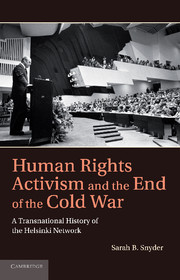Book contents
- Frontmatter
- Contents
- Acknowledgments
- Introduction
- 1 Bridging the East–West Divide
- 2 “A Sort of Lifeline”
- 3 Even in a Yakutian Village
- 4 Follow-up at Belgrade
- 5 Helsinki Watch, the IHF, and the Transnational Campaign for Human Rights in Eastern Europe
- 6 Human Rights in East–West Diplomacy
- 7 “A Debate in the Fox Den About Raising Chickens”
- 8 “Perhaps Without You, Our Revolution Would Not Be”
- Conclusion
- Bibliography
- Index
1 - Bridging the East–West Divide
The Helsinki Final Act Negotiations
Published online by Cambridge University Press: 01 June 2011
- Frontmatter
- Contents
- Acknowledgments
- Introduction
- 1 Bridging the East–West Divide
- 2 “A Sort of Lifeline”
- 3 Even in a Yakutian Village
- 4 Follow-up at Belgrade
- 5 Helsinki Watch, the IHF, and the Transnational Campaign for Human Rights in Eastern Europe
- 6 Human Rights in East–West Diplomacy
- 7 “A Debate in the Fox Den About Raising Chickens”
- 8 “Perhaps Without You, Our Revolution Would Not Be”
- Conclusion
- Bibliography
- Index
Summary
The official CSCE negotiations began in November 1972, and for two and a half years, thirty-five European and North American states debated what became known as the Helsinki Final Act. By the time the agreement was signed on August 1, 1975, the content bore little resemblance to early Soviet proposals. Instead, the text included a number of unique elements advocated by Western and neutral and nonaligned (NNA) states that led to the CSCE's surprising influence on East–West relations. The agreement's follow-up mechanism, commitment to respect human rights, and provisions for human contacts all fostered the development of a transnational network that played an important role in shaping political and social change in Europe in the late 1980s.
A number of earlier works, predominantly written by diplomats engaged in the CSCE negotiations, have addressed the years of talks that produced the Helsinki Final Act and examined the process by which thirty-five delegations finally reached a consensus. This chapter builds upon their accounts and other more recent scholarship. It begins by explaining why the Soviets lobbied for the conference beginning in 1954, and why Western states ultimately agreed to participate. My discussion, however, focuses more closely on how the NATO caucus succeeded in transforming the CSCE agenda and reshaping it to the West's long-term advantage despite many internal disagreements and an overall lack of foresight as to the significance of the Helsinki Final Act.
- Type
- Chapter
- Information
- Human Rights Activism and the End of the Cold WarA Transnational History of the Helsinki Network, pp. 15 - 37Publisher: Cambridge University PressPrint publication year: 2011

